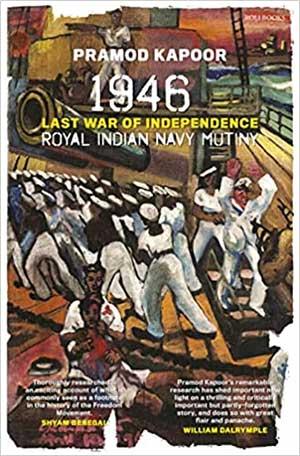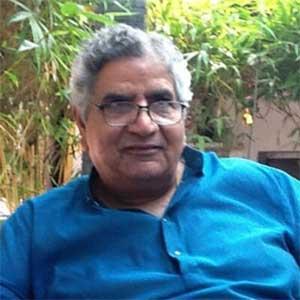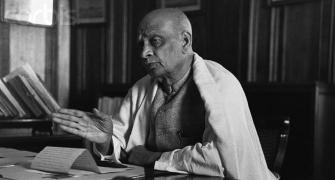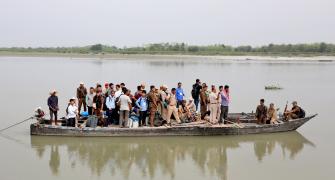'These naval sailors should have been given due respect as freedom fighters.'
'February 18, 1946 should be as important as January 26 because that date changed everything.'

Most of the recent recruits to the Royal Indian Navy were very young.
When they returned after fighting World War II under the British flag, it was to hear tales of how an army led by Netaji Subhas Chandra Bose was fighting to free India from the yoke of British imperialism.
The young sailors were inspired. They were also angry about the terrible service conditions and the discrimination they were facing in the navy; many of them had joined believing in the false promises made by the recruiting British.
In 1946, 20,000 non-commissioned sailors of the Royal Indian Navy mutinied. In less than 48 hours, they took over 78 ships and 21 shore establishments and replaced British flags with the entwined flags of the Congress, the Muslim League and the Communists.
The British knew they could not hold on to India if the armed forces revolted.
The government in England announced a Cabinet Mission to discuss the modalities of transfer of power and the process of Independence was hastened.
Yet, when one talks of India's Independence movement, the story of the 1946 Naval Mutiny is never recounted.
Pramod Kapoor, author and founder of the publishing house, Roli Books, tells Rediff.com Senior Contributor Sheela Bhatt why such an important chapter of India's history is buried under the sands of time.
Kapoor hopes to correct this glaring error in his new book, 1946 Royal Indian Navy Mutiny: Last War Of Independence.
What fascinated you about the 1946 Naval Mutiny? Why did you decide to write about it now?
While I was writing Mahatma Gandhi's biography (Gandhi: An Illustrated Biography, 2017), I speed-read a hundred volumes comprising his collective works.
When I came to Volume 89-90, which dealt with the first few months of 1946, I came across a mention of the Naval Mutiny. There was some reference to a discussion between Mahatma Gandhi and Aruna Asaf Ali (who hoisted the national flag at Bombay's Gowalia Tank maidan during the Quit India movement on August 9, 1942). There were disagreements between Sardar Patel and Jawaharlal Nehru as well.
Sardar Patel wrote to Mahatma Gandhi saying he has asked Nehru to not visit Bombay at that time as it would only inflame the situation.
The fascinating part of the story is that the ratings -- the sailors were called ratings at that time -- who had rebelled were as young as 15-24 years old.
They were greatly influenced by the Indian National Army and Subhas Chandra Bose.
What the INA was doing in the Far East was inspirational.
The atmosphere was such that people taunted the Royal Indian Navy sailors saying, 'You are still taking salary from the British. Look at the INA who have defied everybody. They are fighting for their motherland,' and so on.
When World War II began in 1939, there was a massive mobilisation of sailors in India. From approximately 2,000-3,000, the numbers swelled to 30,000.
The British issued advertisements luring people into the armed forces; all kinds of promises -- including that the recruit's life would be transformed -- were made.
This kind of false propaganda was one of the factors that led to the mutiny.
Most of the recruits were poor and came from villages. They were rapidly employed in the Royal Navy and Armed Forces.
The naval recruits soon realised there was racial discrimination, the food was bad, 20 people were shoved in rooms that was meant to hold only 10... and that their white fellow sailors did not have to face these kinds of problems.
These issues too instigated them to revolt.
Another major factor was GandhIji's 'Do or die' call as he launched the Quit India movement on August 8, 1942.
Achyut Patwardhan (he founded the Socialist Party of India in 1947), Minoo Masani (a leading face of the Swatantra party, founded after Independence by C Rajagopalachari, the last governor general of India), Jayaprakash Narayan (a prominent leader of the Socialist Party and one of the strongest voices against the Emergency imposed on India in 1975 by then prime minister Indira Gandhi) and others were arrested; some of them went underground.
The ginger group (a formal or informal group within an organisation seeking to influence its direction and activity, explains Wikipedia) of leftists in the Congress -- like some other Indians who did not believe in what Gandhiji was doing -- was getting fed up. They thought non-violence would not get them anywhere.
They believed violence was required if India wanted to snatch her independence from the British.
It was around this time at Aruna Asaf Ali went underground. Her properties were auctioned and she suffered a lot. She only came back in about mid-1945 when Gandhiji personally appealed to return.
Soon, she got in touch with some people from the armed forces, primarily the sailors from the navy since a couple she knew -- Kusum and P N Nair -- introduced them to her at their apartment in Marine Drive (south Bombay).
And the seed of the mutiny was sown.
Young sailors would come on Sundays -- or what they called liberty time -- to listen to her and other radicals. Members of Indian People's Theatre Association like Salil Chowdhury, Khwaja Ahmad Abbas and Prithviraj Kapoor would come and lend their moral support.
On December 1, 1945 -- December 1 was, and continues to be, celebrated as Navy Day -- the British navy, for the first time, decided to invite the who's who of Bombay to visit the ships. They wanted to show how liberal they were and what a big thing they had done by allowing Indians to be part of the navy.
That's when B C Dutt, the man who started the mutiny, and R D Purie (his nephew Aroon Puri, is the founder-publisher and former editor-in-chief of India Today) wrote seditious slogans on HMIS Talwar's walls -- 'Down with the British', 'Kill the British' and other such statements -- under cover of darkness.
In the morning, when the invitees boarded the ship, the slogans greeted them.
Dutt and Purie got away with it.
They repeated their act on February 1, 1946, when the British commander-in-chief of India, General Claude Auchinleck, was supposed to give a speech. Below the podium that he was to use, they wrote the same slogans.
Unfortunately, that night, they were caught because they had a gum bottle in their hands that they were using to stick the posters.
The ship's commandant was furious and called them sons of coolies, etc.
In the army, if three people rebel, it's called a mutiny.
On February 18, the sailors raised slogans against the British and the mutiny officially started.
Since these sailors were from the signal school, all the ships came to know within two hours that these boys had mutinied.
The British panicked.
On the 18th itself, there was a discussion in the House of Lords and the House of Commons in England. That very afternoon, they announced a Cabinet Mission to discuss the transfer of power.
The mission included a British global navy chief (Albert Victor Alexander, then the first lord of the admiralty). There was no reason for him to come to India at that point; his real job was to put an end to the mutiny and the panic it had created.
The news of the mutiny appeared in all the newspapers.
The sailors wanted the mutiny to be peaceful. At the same time, they were determined that they would deliver the Royal Indian Navy to the Indian government of Independent India.
They could dream like that because they were innocent boys.

How many sailors joined the mutiny?
It started from the HMIS Talwar and, initially, there were just 1,000 people.
But, within 48 hours, some 20,000 sailors, 78 ships and 21 shore establishments had gone on strike all over India.
Apart from announcing a Cabinet Mission, the British sent one of their biggest warships in Indian waters. It sailed rapidly towards Bombay to scare the mutineers. Its planes flew low sorties above the dockyard and around the Gateway of India.
The sailors had taken control of all the ships around Bombay.
They took down the flags of the British navy and replaced it with the flags of Muslim League, the Congress and the Communist party.
When the low sorties began, the Indian boys pointed their four-inch Bofors guns towards the Gateway of India, the Yacht Club and Naval Dockyard and said, 'If you harm us, we will blow up all these buildings.'
The politicians had to intervene to calm the situation.
Senior leaders like Sardar Patel and Maulana Azad, who was the president of Congress at the time, started pacifying the sailors.
'There is no point doing this (mutiny),' they said. 'The Britishers are very powerful, they have everything at their command.'
Instead of guiding the sailors towards doing something, they made them surrender.
The young sailors argued back, 'Look, we are trained to fight with guns, we are not trained to fight with charkhas (spinning wheels, symbolic of the non-violent fight for freedom). We will fight till the end; it doesn't matter if we perish.'
But there was a difference of views between the senior and junior sailors.
In the end, the senior sailors prevailed and at 6.30, two minutes before their deadline, they surrendered.
When Sardar Patel had asked the sailors to surrender, he had assured them that there would be no repercussions. Unfortunately, there were.
Once they had surrendered, 400 of them -- whom they called the ring leaders -- were jailed.
The worst is that, even after India became independent, all of them had to plead with the government to reinstate them or give them an alternate job.
In reply, they received a two-line cyclostyled letter saying the Government of India had decided anyone who was dismissed from the navy because of the mutiny would not be reinstated and those who were dismissed with disgrace would not even be offered civilian jobs.
Why didn't the political leaders help?
In 1946, the senior political leaders saw that Independence was imminent and they were not ready to share the credit by supporting the mutiny.
I believe Independence came earlier because of the Naval Mutiny and also due to the disturbances in the armed forces.
I also believe that none of the politicians wanted to rock the boat.
After India got freedom, the senior leaders said that the discipline in the army cannot be tampered with.
The other reason was that, till 1958, India's chiefs of the naval staff were British (India had four British chiefs of the naval staff before Vice Admiral Ram Dass Katari took over on April 22, 1958); they couldn't have accepted the people who actually rebelled against British while leading the force.

Why has the 1946 mutiny been underplayed in India's history books?
The Congress didn't want it. I think they felt guilty about it.
Even in 1965, when (actor) Utpal Dutt staged a brilliant play called Kallol in Bengal, the Congress -- which was then ruling in the state -- made sure it was sabotaged.
Dutt had created a marvellous set. Youth Congress volunteers went there to protest. The CPI- M cadre surrounded the set and made sure it wasn't destroyed.
It was the most popular play at the time. They could not stop it. So they arrested Utpal Dutt and the play was closed down.
Who inspired the sailors?
Everyone was bound by their party line.
Nehru was sympathetic towards the sailors in beginning, but, later, he succumbed to the pressure and started talking about discipline in the armed forces, etc.
The Muslim League leaders were only addressing the Muslim sailors.
But, strangely, the Muslim League, the Congress and British were on the same side when it came to the mutiny. All of them wanted it to end.
The Congress was divided. Young Turks like Aruna Asaf Ali, Jayaprakash Narayan and Biju Patnaik supported the sailors while elder statemen like Sardar Patel and Maulana Azad were on the other side.
They were on the streets, fighting the British since 30-40 years. How could they give the credit of getting Independence for India on a platter to these youngsters?
After all, in a situation like this, many people will have a soft corner for those who fought violently than those who were non-violent.
My biggest objective behind writing this book was that these naval sailors should have been given due respect as freedom fighters. February 18, 1946 should be as important as January 26 because that date changed everything.
The Cabinet Mission was sent to India and we became independent earlier because of the mutiny. The British were petrified that if all three defence forces rebelled, they would not be able to control the situation.
What did Gandhiji say?
Gandhiji was clear that he could not support violence. He said sailors were badly advised; that they were thoughtless and ignorant if they believed that, by their might, they would deliver India from foreign domination.
 IMAGE: Pramod Kapoor. Photograph: Kind courtesy Pramod Kapoor/Twitter.com
IMAGE: Pramod Kapoor. Photograph: Kind courtesy Pramod Kapoor/Twitter.comAnd what was Nehru's reaction?
In the beginning, Nehru openly supported the ratings.
On February 26, when Sardar Patel and Nehru addressed a mammoth rally at Chowpatty, he even said they had made them surrender by making promises they were not capable of keeping.
I think Nehru saw a big role for himself in independent India so, later, he didn't support the sailors.
The Congress refused to treat this as a freedom movement; they treated it as a mutiny. My surmise is they didn't want credit to go to the sailors.
And the history books?
The Congress did not want this mentioned in the history books because, then, the public would give most of the credit to these sailors.
In those days, the Congress did not want any movement that was not blessed by them to succeed.
The newspapers reported the violence that broke out in Bombay. More than 400 people died. These deaths are not given due space in our history books.
These people died in police firing. The streets of Bombay had erupted overwhelmingly in support of the naval mutineers.
Feature Presentation: Ashish Narsale/Rediff.com








